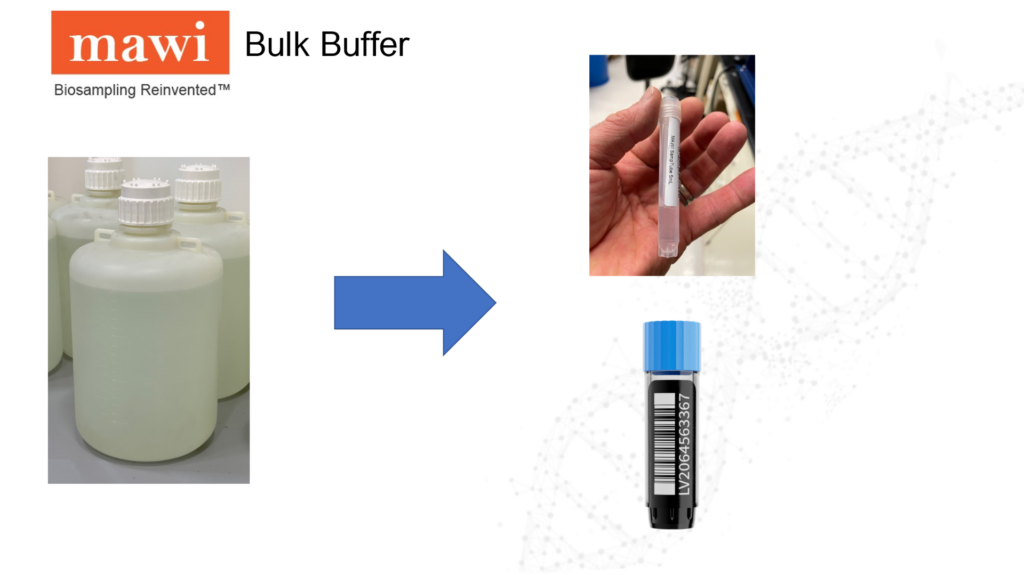Didn’t find what you were looking for?
Send us an email and we’ll get in touch with you
info@mawidna.comiSWAB patented technology utilizes a tube insert which allows for collecting/concentrating sample into a single tube, while also removing the need to soak/rock samples with the used swab. iSWAB provides transport, stabilization, and long-term storage all at room temperature.
iSWAB-DNA-1200, iSWAB-DNA-250, iSWAB-DNA-DSC all function the same, with the only differences being the volume of the buffer included, number of swabs used, and total DNA yield.
Any sterile swab is compatible as long as the head size is ≤ 4.3 mm in diameter. The swab material can be cotton, rayon, Dacron, nylon fibers, or flocked swabs. If you want extra swabs like the ones that came with the kit, then you can order them directly through us.
The iSWAB squeegee “squeezing” insert is designed to be accessed by 200 -300 µL or lower volume tips; the 1 mL tip is too large for the device. The quality of DNA/RNA and the yield from 200-300 µL of the collected sample are more than sufficient for your downstream application. This was designed to help reduce plastic waste and cost for sample processing, thus being more environmentally friendly and improving lab storage real estate savings and turnaround time due to the small footprint of the iSWAB device.
In our lab, we use Integra and any standard 200 µL pipetting tips for manual extraction in-house.
Recommended pipetting tips:
Automation:
Automation Compatibility – Mawi DNA – The Future of Biosampling
iSWAB automated liquid handling compatible platforms:
Yes, you can! Our buffer technology is based on stabilizing the sample providing the highest quality and thus we made our technology even more flexible to work with. We work routinely with our customers to custom-fill their current tube format with our stabilizing buffer. Or we provide our stabilizing buffers in jugs of 1L or 20L, and you can use your fulfillment facility to fill your own tubes. Inquire about bulk buffer & custom tube filling to: sales@mawidna.com

The proprietary iSWAB buffer is non-toxic and does not contain any alcohols, organic/inorganic solvents, chaotropic agents, or any guanidine/guanidine-like salts.
The shelf life of unused products is 3 years for DNA products and 18 months for others from date of manufacture. All products are built-to-order, so each shipment will have the longest possible shelf life.
Yes, iSWAB-Respiratory Tract Sample Collection Media-EL (iSWAB-RC-EL) is FDA 501(k) Cleared and approved for IVD. 510(k) Number: K221802
iSWAB-RC-EL is an extraction-less medical device and samples can be used directly into PCR/QPCR or similar molecular downstream applications for respiratory tract infections. There is no need to extract nucleic acids; however, in rare cases a slight dilution or short pre-heat of the sample may be necessary to prevent assay inhibition.
The following assays are compatible with iSWAB-RC-EL:
No, a pre-draw is not required before collecting into HemaSure-OMICs tubes. You may collect blood with HemaSure-OMICs tubes in any draw order.
A single HemaSure-OMICs blood tube is suitable for DNA, RNA, and cfDNA isolation. One tube – three analytes.
Yes, Mawi DNA Technologies is ISO 13485 certified.
All Mawi DNA products can be transported and stored at room temperature. No need for dry ice or refrigeration.
Yes, we can offer a few free samples for validation or for customers wanting to validate Mawi DNA products in exchange for the data they produce.
Please contact us for advice.
